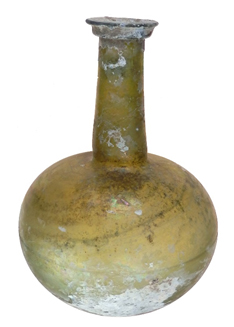
Among the Abbey Museum’s more recent acquisitions is a collection of forty-four objects from Turkey, Tunisia and Papua New Guinea including an amazing intact Roman glass flask. It is incredible to have such a fragile object in our collection, considering it was used by someone when togas were all the fashion and attending chariot races or watching gladiatorial battles were on the top of the entertainment list.
Our very fine large bulbous flask in green-yellow glass originated in the Roman Imperial Period and dates somewhere between the 1st and 3rd Century AD. Now to get a little technical – the flask has a slightly retracted base and long thin cylindrical neck ending in a solid rim with a rounded lip and flaring mouth. It was blown to a very fine standard and has this beautiful iridescent weathering and lime encrustation.

The glass in our flask has iridescence where it has oxidised. This is a good sign as it indicates that this flask had been underground for much of the time before being discovered.
Making Roman Glass
Roman glass was created around 2,000 years ago, using a similar glass-blowing technique to that used today. Glass blowing began around the 1st century BC. This was about the same time as the formation of the Roman Empire. The new technology was supported by the government and glass was eventually produced in many parts of the Roman world, primarily Cyprus, Syria and Egypt. During the reign of Augustus, glass blowing production began on a large scale with the invention of the blowpipe in Sidonian Phoenicia. After this region was annexed to the Roman world in 64 BC, techniques were thought to have arrived back in Rome with craftsmen and slaves.
The Making of Glass
Glass making involves sand (silica) being mixed with soda (sodium carbonate), which lowers the melting pot of the silica to form glass. The main source of soda was natron, a naturally occurring salt found in dry lake beds. Natron came from Egypt, at Wadi El Natrun, although there may have been a source in Italy. The stabiliser was usually lime, as silica and soda were naturally soluble. The different types of sand used to manufacture ancient glass often contained iron impurities which gave it colour. The iron ions gave the glass a light-green tinge and the sulphurs in the sand, mainly in the form of sodium sulphate, gave colours from yellow to dark green.
The siting of glass-making workshops was governed by availability of what was required for production:
- fuel, which was needed in large quantities
- sand, which forms the major constituent of the
glass - soda based natron, to act as a flux.
The Glassblowing Revolution
Glassblowing technology revolutionized the Roman glass industry, with an enormous increase in the shapes and designs. As a result the output increased enormously. Creativity was no longer limited by the restrictions of the arduous casting process. Blowing allowed for much greater versatility and speed of manufacture. With glassblowing workers produced vessels with thinner walls which decreased the amount of glass needed for each vessel.
This technique was also much quicker and vessels required less finishing, saving in time, raw materials and equipment. Thus the cost of production was reduced and glass became available to a wider section of society in a variety of forms. By the middle of the 1st century AD, glass vessels had changed from being a valuable, high-status product, to one that was commonly available, with a glass cup able to be bought for a copper coin. With Roman glass being so popular, much has survived to the present day.
Aren’t we fortunate to have such a fine specimen of a Roman Glass flask in the Abbey Museum! It has a stunning look that could feature in any modern home today. Visit soon to see our many treasures.

